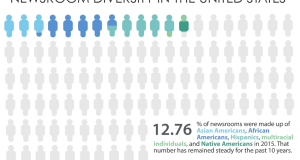AAJA will have four vice presidents under a proposed restructure of its national governance system.
If approved, the proposal would replace the vice presidents of print and broadcast with a vice president of public affairs and a vice president of programming. The positions of senior vice president and vice president of technology also would be added.
The new vice presidential positions would be responsibility-based rather than platform-focused, AAJA President Paul Cheung said.
“We’re not saying that the platform is not important, but so much of what we do now is cross-platform,” Cheung said. “What we want to do is create a structure that is free from vocations that really focuses on the mission of AAJA. The existing structure was just too large and unwieldy in the industry.”
National Secretary Michelle Lee said leaders have gotten feedback from membership saying the current structure isn’t the best.
“What we’re trying to figure out is, how can we can improve it so that the organization is more flexible … and better suited for journalism’s evolving needs,” Lee said.
Discussion on changing AAJA’s governance structure has been going on for over two years. While both the advisory and governing boards agree change is necessary, there is debate around the official titles and areas of responsibility for the positions.
Currently, AAJA’s Board of Directors consists of two bodies: an advisory board, made up of representatives from local chapters that serves as an advising body, and the governing board. The governing board votes on all final decisions and consists of representatives for small, medium and large chapters and at-large representatives elected by the advisory board. It also includes the executive positions — national president, vice president for print, vice president for broadcast, treasurer and secretary, who are elected by the entire membership.
The idea to restructure came out of a discussion on AAJA’s mission.
“One big part [of the mission] is advocating for diversity and making sure we are reaching out to the community,” said Yvonne Leow, AAJA vice president for print. “We don’t really have people who are dedicated to that because … it was very much oriented around craft.”
Leow said that with the new structure the responsibilities of the position and the skills needed to carry those responsibilities will be clearer, not only for those running to fill them, but for the membership who vote for them.
Another change in the governance structure would change the makeup and role of the advisory board. Chapter representatives would not be required to attend every meeting, granting those on the advisory board more flexibility in their roles as advisers, and potentially removing the burden of travel expenses from smaller chapters.
“I don’t think this will be a once-and-for-all solution, but I think the idea is to make us more nimble and adaptable to whatever happens so we don’t have to constantly make this huge reform in order to catch AAJA up to whatever is going on in the industry,” Leow said.
Since proposing the change, AAJA leadership has surveyed the advisory board and the membership, reached out to all levels of leadership, and held a town-hall conference in March to gauge the interest of AAJA members and get feedback.
“I think that says a lot about AAJA as an organization and how we approach problem solving,” Leow said. “It’s much more about consensus building than it is about just dictating what we think is best.”
If approved, the implementation of the new structure will take effect in 2015 and slowly phase in over two elections, with full implementation by 2018. The proposal will be discussed in the advisory and governing board meetings before going to a vote on Sunday.
“We’re talking about [adapting to changes in the industry] in our own careers,” Lee said. “I think it only makes sense that we as an organization talk about it, too.”
Follow @Kikahiga on Twitter.
 VOICES Publishing from the AAJA National Convention
VOICES Publishing from the AAJA National Convention







